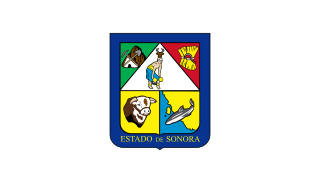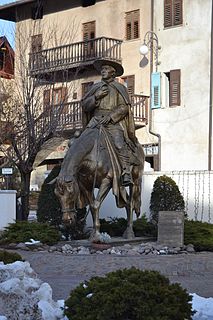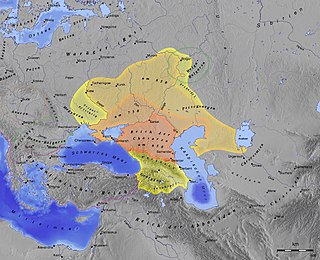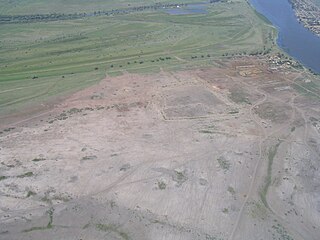
Samandar was a city in Khazaria, on the western shore of the Caspian Sea, in what is now Dagestan. At some later date, it may have been moved inland to Shelkovskaya in the Chechen Republic.

Sonora, officially Estado Libre y Soberano de Sonora, is one of 31 states that, with Mexico City, comprise the 32 federal entities of United Mexican States. It is divided into 72 municipalities; the capital city is Hermosillo.
Sonora is bordered by the states of Chihuahua to the east, Baja California to the northwest and Sinaloa to the south. To the north, it shares the U.S.–Mexico border with the states of Arizona and New Mexico, and on the west has a significant share of the coastline of the Gulf of California.

Hermosillo, formerly called Pitic, is a city located centrally in the northwestern Mexican state of Sonora. It is the capital and largest city as well as the main economic center for the state and region. As of 2015, the city has a population of 812,229 inhabitants, making it the 16th largest city in Mexico. The recent city population spur is due to its recent strong industrialization, especially in the automotive industry.

Eusebio Francisco Kino was a Jesuit, missionary, geographer, explorer, cartographer and astronomer born in the Territory of the Bishopric of Trent, then part of the Holy Roman Empire. For the last 24 years of his life he worked in the region then known as the Pimería Alta, modern-day Sonora in Mexico and southern Arizona in the United States. He explored the region and worked with the indigenous Native American population, including primarily the Tohono O'Odham, Sobaipuri and other Upper Piman groups. He proved that the Baja California Peninsula is not an island by leading an overland expedition there. By the time of his death he had established 24 missions and visitas.
Saqsin was a medieval city that flourished from the eleventh to the thirteenth centuries. It was situated in the Volga Delta, or in the Lower Volga region, and was known in pre-Mongol times as Saksin-Bolgar, which in Mongol times became Sarai Batu.
It was mentioned by the Arab geographer al-Gharnati and the Persian Qazwini, among others, and recorded as "the land of the Saksins" in the report of Friar Benedykt Polak about the 1246 trip of Giovanni da Pian del Carpine through the camp of Mongol prince Batu Khan on the shores of the Volga. S.A. Pletneva locates Saksin between present Volgograd and Akhtubinsk.
Barsils / Barsilts, Chinese Baysi, were a semi-nomadic Eurasian tribe of Turkic linguistic affiliation. Barsils in turn evolved into modern Karachays and Balkars, and possibly identical with the Bagrasik. Barsils are first mentioned in the Chinese annals as the 15th of the 15 Turkic Tele tribes. The Chinese records about the Western Turkic Kaganate c. 630 mention a Khan of the Bars tribe, a member of five "Nushibi" on-shadapyt right wing tribes, under a name of Tun-ashpa [ra]-erkin. Barsils are included in the list of steppe people living north of Derbend in the Late Antique Syrian compilation of Zacharias Rhetor, and are also mentioned in documents from the second half of the 6th century in connection with the westward migration of the Eurasian Avars. When the Avars arrived, according to Theophylact Simocatta, "the Barsilt (Barsilians), Onogurs, and Sabirs were struck with horror (...) and honoured the newcomers with brilliant gifts."

Hajji Tarkhan, also known as Hashtar Khan / Actarxan or Astrakhan, was a medieval city at the right bank of Volga, situated approximately 12 km north of the modern city of Astrakhan. The first mention of the town was recorded in 1333. In the 13th and 14th centuries it was one of the main trade and political centres of the Golden Horde. In 1395 the city was sacked by Timur. Astrakhan was rebuilt afterwards and became the capital of the Khanate of Astrakhan in 1459. In 1547 the city was seized by the Crimean khan Sahib Giray. In 1556 Astrakhan was besieged and burned by Ivan the Terrible.

In the accounts of ibn Khordadbeh and other Muslim writers, Khamlij or Khamlidj refers to the capital of the Khazars. Most scholars agree that Khamlij is the Khazar city of Atil. However, no source positively identifies one with the other; it is therefore possible that Khamlij was a specific district within Atil or a separate city altogether.

The Spanish missions in the Sonoran Desert are a series of Jesuit Catholic religious outposts established by the Spanish Catholic Jesuits and other orders for religious conversions of the Pima and Tohono O'odham indigenous peoples residing in the Sonoran Desert. An added goal was giving Spain a colonial presence in their frontier territory of the Sonora y Sinaloa Province in the Viceroyalty of New Spain, and relocating by Indian Reductions settlements and encomiendas for agricultural, ranching, and mining labor.

Santa Teresa de Átil also known as Santa Teresa de Ádid and Los Siete Príncipes del Átil, is a historic Spanish mission located in the small town of Atil, Sonora.

In the Middle Ages, the Volga trade route connected Northern Europe and Northwestern Russia with the Caspian Sea, via the Volga River. The Rus used this route to trade with Muslim countries on the southern shores of the Caspian Sea, sometimes penetrating as far as Baghdad. The route functioned concurrently with the Dnieper trade route, better known as the trade route from the Varangians to the Greeks, and lost its importance in the 11th century.

Ures is a small city and a municipality in the Mexican state of Sonora.

Samosdelka is a fishing village in southern Russia near which archaeologists reported in September 2008 that they had found the remains of Atil, the capital of the medieval Khazar kingdom.
Altar is a municipality in Sonora in north-western Mexico. The municipality had a 2010 census population of 9,049 inhabitants, the vast majority of whom lived in the municipal seat of Altar, which had a population of 7,927 inhabitants. There are no other localities with over 1,000 inhabitants.
Atil (municipality) is a municipality in Sonora in north-western Mexico.
Oquitoa Municipality is a municipality in Sonora in north-western Mexico.
The following television stations broadcast on digital channel 14 in Mexico:











